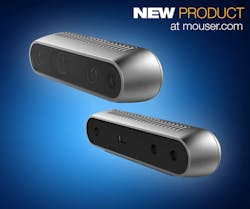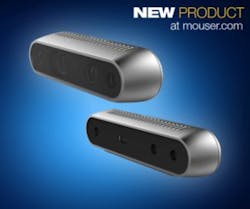Mouser offers Intel RealSense D400 Series depth-sensing cameras
Mouser Electronics Inc. announced it is now stocking the Intel RealSense D400 product family. Built specifically to help embedded systems sense, understand, interact, and learn from real-world environments, the Intel RealSense D400 product family offers designers a comprehensive platform of ready-to-use cameras, depth modules, and vision processors that deliver embedded depth-sensing technology, real-time processing, and high-speed 3D imaging that is versatile and robust for a variety of indoor and outdoor applications.
For higher volume embedded applications, Intel offers the Vision Processor D4 and Depth Module D400 Series, also available from Mouser Electronics. The compact Vision Processor D4 computes high-resolution 3D depth maps in real time without requiring a dedicated GPU or host processor when paired with RealSense Depth Modules. The D400 Depth Module Series can capture indoor or outdoor environments with long-range capabilities, high-depth resolution, and IR stereo, and they are offered with multiple options, including standard or wide field of view, rolling or global shutter technology, and passive or active IR depth sensing.
The Intel RealSense Depth Camera D400 product family is supported by a cross-platform (Windows, Linux, macOS) and open-source software development kit (SDK), which features libraries, wrappers, computer-vision sample code, and tools to help designers start coding projects and debugging camera settings. Additionally, designers can quickly download the Intel RealSense viewer for use with either the D435 or D415 Depth Camera to quickly evaluate the D400 product family.

